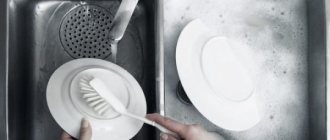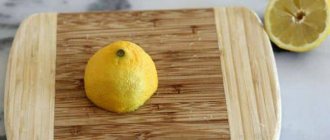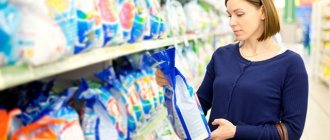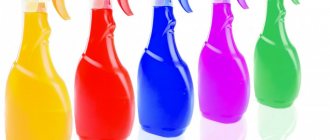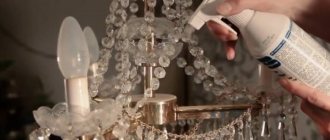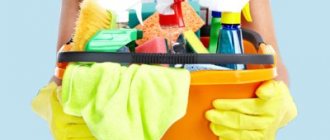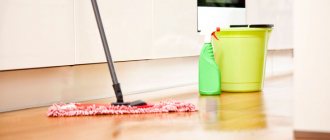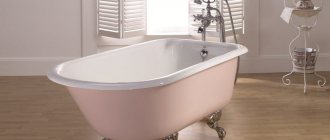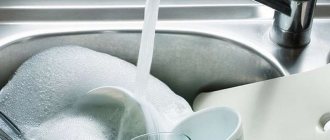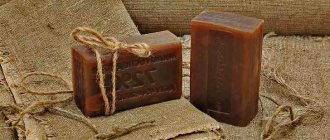When a child appears in the family, parents should be concerned about choosing safe household chemicals and hygiene products. Gel for washing children's dishes is an essential element of care. Specialized compounds will help remove dirt and germs from household items intended for the little discoverer.
Photo: Pixabay.com
Selecting the optimal products is not so difficult, because most of the largest companies produce “children's lines”.
Depending on the consistency, textures can be:
- Creamy.
- Gel.
The basis of the formula, in this case, is:
- Surfactants, preferably of natural origin.
- Auxiliary ingredients - antibacterial, softening, moisturizing and other additives.
- Extracts of medicinal plants.
When choosing a detergent for washing children's dishes, you should pay attention not only to the composition, but also to:
- Smell, color. Products with strong fragrances and artificial colors should be avoided.
- Easy removal from surfaces. The components must dissolve easily upon contact with water - this is a very important aspect.
- Disinfectant properties.
- Container volume.
- Viscosity of texture - thick ones are economical in consumption.
- Ability to remove different types of contaminants.
- Ease of use.
Introducing the rating of baby dishwashing detergents 2022. The top 8 products that were selected by our experts based on user reviews and ratings.
| Rating (2021) | Prices, ₽ | A country |
| 1. Frosch | from 200₽ | Germany |
| 2. Meine Liebe Concentrated | from 160₽ | Russia |
| 3.BabyLine | from 120₽ | Belgium |
| 4. Pure Water | from 150₽ | Russia |
| 5. Synergetic Antibacterial | from 90₽ | Russia |
| 6. Eared Nian Chamomile and aloe | from 80₽ | Russia |
| 7. AQA baby | from 120₽ | Russia |
| 8. Fairy | from 100₽ | Russia |
Reviews from moms
Oksana, 28 years old
Recently my baby started drinking from bottles - not only milk, but also juices and water. These utensils should always be clean. But you can’t wash bottles with just anything. I chose the Eared Nannies gel. It is gentle, gives a light foam and quickly washes everything from the inside.
Yulia, 49 years old
I buy the best for my little granddaughter and try to take care of her health. In addition to environmentally friendly toys, I also take BioMio, a natural detergent for children’s dishes. No chemicals or other hazards.
Ulyana, 33 years old
I have three small children, and there are always a lot of dirty dishes in the kitchen. The special product Umka helps to cope with old fat and even dried milk. It is inexpensive, effective, but the most important thing is its naturalness and natural ingredients that will not harm children.
How to wash feeding bottles?
Many people wonder how to wash baby bottles, since the baby’s immune system is very vulnerable. But many newborns are bottle-fed literally from the first days and are constantly in contact with their first utensils. Therefore, the question of how to wash feeding bottles is very relevant.
It is recommended to boil the bottles themselves, nipples and attachments for them for several minutes before the first use, and then rinse them with boiling water before each feeding. The same recommendations apply to the first plates, spoons and cups for babies.
How to remove yellowness
Over time, a reddish coating appears on plastic dishes. It is effectively cleansed by a gel produced under the Nuk brand. In the absence of this remedy:
- You need to pour the cereal into the bottle, fill it with water, close it and shake thoroughly.
- Pour a soda solution into the dishes and wipe with a brush.
- Yellowness is removed with boiling water and a washcloth.
If bottles are disinfected in a sterilizer, plaque will not form. To remove unpleasant odors, use a toothbrush.
Cleaning brushes
Plaque settles on the walls of the bottles, food debris accumulates, in which microbes begin to multiply. Not all detergents dissolve deposits; they can be removed with a special sponge or other device.
With foam tip
There are several types of brushes; they do not scratch glass or plastic, but a product with a foam tip that extends when you press a button copes with dirt and deposits.
Companies Dr. Brown
The brush, produced by a well-known company, consists of a sponge and bristles, easily penetrates inside a bottle with a narrow neck, cleans the remaining mixture, removes plaque, and attaches to the surface with a suction cup.
With sponge
It is convenient to wash pacifiers and baby dishes made of glass and propylene using a brush with a sponge made of natural porous material. When the brush rotates, the bottom of the bottle is well cleaned and milk residues are removed from the protrusions.
2 in 1
A double-sided brush equipped with a sponge is designed for daily care of baby dishes, pacifiers, and pacifiers. It not only removes food debris, but also kills germs with the help of bristles.
Chicco
The brush of this model performs several functions. Tweezers are built into the handle of the item, which makes it easy to remove bottles after sterilization.
The need for sterilization
The immune system of newborns and infants is not always able to cope with bacteria that live in the external environment. Microbes that enter the baby's digestive tract during bottle feeding cause stomach upset, the baby loses appetite and can become seriously ill. Bacteria settle and multiply in water from taps and wells; the source of infection is the milk formula that is fed to the baby.
Sterilization of children's dishes makes it possible to protect the child's fragile body from diseases of the digestive tract caused by microbes. It is necessary to disinfect diapers and dishes only in the first weeks after the birth of a newborn.
What items should be sterilized?
Having figured out why sterilization is needed, it is now worth understanding what should be subjected to this procedure. Such items include:
- water bottles, feeding bottles and pacifiers;
- pacifiers, it is better to have at least two of them;
- breast pump and related parts;
- teething toys or other items that can get into the baby's mouth and will not be damaged during the heat treatment process.
After sterilization, everything should be dried and prepared for further use.
In the sterilizer
Grandmother’s methods are, of course, good and effective, but now there are many kitchen appliances that make life easier for young mothers. One of them is a sterilizer. There are quite a few brands that produce these devices, including very well-known and very young manufacturers of household appliances. There is something for every taste and price.
Processing in the sterilizer occurs using steam; only this device is used directly for the child’s items, which ensures greater safety. In addition, other devices can simply be occupied with preparing food for the whole family.
A sterilizer can be purchased at any hardware store or children's world.
Water is poured into the lower compartment of the device, and the dishes must be placed on top. After starting the device, the sterilization procedure starts and lasts for the time programmed in the device. It can even sterilize plastic bottles.
Cold way
After trying different sterilization options, mom will be able to determine which one she likes best. Since there are quite a lot of them, you can use regular boiling or carry out the procedure in a slow cooker; all options are quite effective and perform this function efficiently.
If a mother and child are on the road and it is not possible to use one of the above sterilization methods, there is the so-called cold treatment. You will need to buy a special drug at the pharmacy - an antiseptic. It is available in tablets, and its effect is no worse than steam.
To carry out this procedure you must:
- dissolve several tablets in water in a sufficiently spacious container;
- place all items that need to be disinfected there;
- keep dishes and toys in the solution for 40 minutes;
- then you should take it out and rinse well to remove any remaining antiseptic.
This option should not be used frequently or at home. Its use can only be forced, but not regular.
All proportions must be maintained based on the parameters specified in the instructions. The indicated dosage should not be exceeded, nor should it be significantly reduced.
Can I use detergents?
When washing, it is allowed to use detergents, namely:
- baby dishwashing detergent;
- baby soap;
- laundry soap.
Some conservative parents do not use detergents, using baking soda, mustard powder or table salt.
However, modern detergents for washing children's dishes contain a minimal amount of harmful substances, which cannot be said about conventional detergents.
It is not always possible to give a child something to drink from a glass. Sometimes it is more convenient to give a child something to drink from a straw. At what age and how to teach a child to drink from a straw, read carefully.
Read on to learn more about postpartum depression and ways to combat it.
The child wheezes, but does not cough - what does this mean? You will find the answer in this article.
In a saucepan
The most common and fairly old method is boiling. You can use any container of suitable size that is designed for heating on a gas or electric stove.
Prepared children's accessories you need:
- place in a saucepan or ladle;
- pour clean water so that it completely covers all objects;
- After boiling, simmer for up to 10 minutes.
Then the dishes need to be taken out and dried. Silicone and rubber nipples take less time to boil and can be taken out earlier. It is convenient to do this with tweezers. For a child older than six months, simply pour boiling water over the pacifier.
